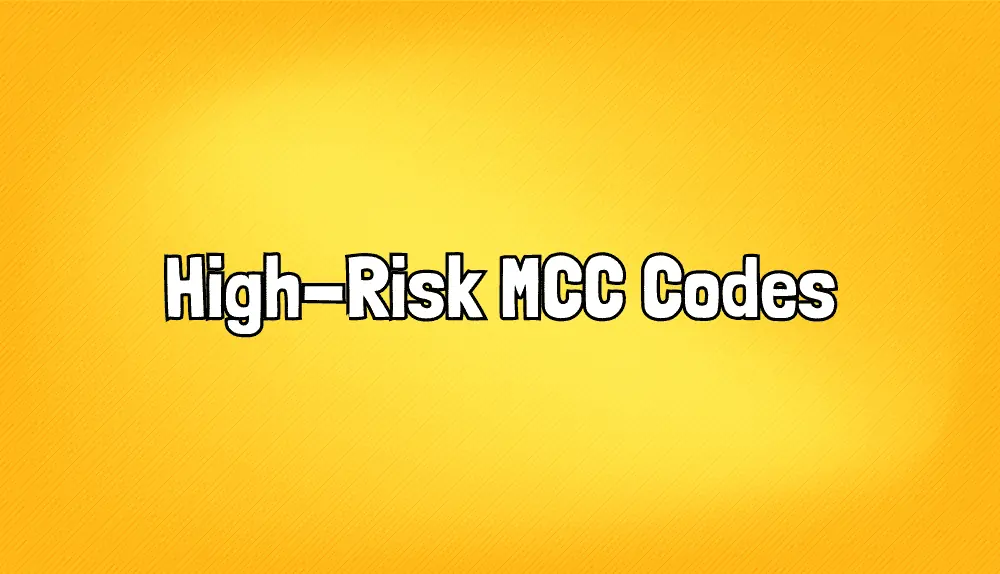Common high-risk MCC codes are a crucial aspect of the modern financial landscape, serving as identifiers for specific high risk merchant account categories that are deemed to carry a higher level of risk. MCC, which stands for Merchant Category Code, is a four-digit number assigned to businesses to classify their industry type. However, certain MCC codes are associated with increased risk due to the nature of the products or services offered by the merchants.
These high-risk MCC codes play a significant role in risk assessment and fraud prevention, enabling financial institutions to identify potential vulnerabilities and take appropriate measures to safeguard against fraudulent activities. Understanding the common high-risk MCC codes is essential for financial institutions, payment processors, and regulatory bodies to effectively manage and mitigate risk in today’s ever-evolving financial landscape.
What is High-Risk MCC Code?

A high-risk MCC code, also known as a Merchant Category Code, refers to a specific four-digit number assigned to businesses within certain industries that are considered to carry a higher level of risk. These codes serve as identifiers for financial institutions, payment processors, and regulatory bodies to assess and manage potential risks associated with different merchant categories. The classification of an MCC code as high risk is typically based on factors such as the nature of the products or services offered by the merchants, historical data of fraudulent activities within that category, and regulatory guidelines.
High-risk MCC codes encompass a wide range of industries, including adult entertainment, gambling and casinos, cryptocurrency, travel agencies, telemarketing, and online auctions, among others. Merchants operating within these categories may face increased scrutiny and additional requirements from financial institutions due to the inherent risk associated with their businesses.
Identifying and monitoring high-risk MCC codes is crucial for effective risk management and fraud prevention. Financial institutions can implement stricter underwriting criteria, enhanced monitoring procedures, and additional security measures to mitigate the risks associated with these high-risk merchant categories. Additionally, regulatory bodies may impose specific compliance requirements and monitoring frameworks for businesses operating within high-risk MCC codes to ensure adherence to legal and ethical standards.
What are High Risk MCC Codes Used For?
High-risk MCC codes are an integral part of the financial landscape, serving as identifiers for merchant categories that carry a higher level of risk. These four-digit codes are crucial in risk assessment, fraud prevention, regulatory compliance, and determining eligibility for financial services. By categorizing businesses into high-risk MCC codes, financial institutions can allocate resources effectively, implement stringent security measures, ensure regulatory compliance, and make informed decisions regarding merchant services. Understanding the uses and significance of high-risk MCC codes is essential for maintaining a secure and robust financial ecosystem.
Risk Assessment and Management
High-risk MCC codes are instrumental in assessing and managing potential risks associated with specific merchant categories. By assigning these codes to businesses, financial institutions, and payment processors can identify industries that are more prone to fraudulent activities or other types of risks. This categorization enables institutions to allocate appropriate resources for monitoring, implementing security measures, and mitigating potential risks. It allows for a proactive approach to risk management.
Fraud Prevention
One of the primary uses of high-risk MCC codes is fraud prevention. Financial institutions leverage these codes to identify merchant categories with a higher likelihood of fraudulent transactions. With this information, institutions can implement stricter underwriting procedures for merchants operating within these categories. They may require additional documentation, perform more thorough background checks, or enforce stricter transaction monitoring. By doing so, they reduce the risk of fraudulent activities and protect both the financial institution and its customers.
Regulatory Compliance
High-risk MCC codes also play a crucial role in regulatory compliance. Regulatory bodies often designate certain merchant categories as high risk due to their susceptibility to money laundering, terrorist financing, or other illegal activities. Financial institutions are required to monitor transactions and report suspicious activities within these high-risk categories to comply with anti-money laundering (AML) and know your customer (KYC) regulations. By using MCC codes, institutions can easily identify and track transactions associated with high-risk merchant categories, ensuring adherence to regulatory guidelines.
Determining Eligibility for Financial Services
MCC codes are also utilized to determine the eligibility of merchants for certain financial services. Some financial institutions may have specific policies or guidelines regarding the industries they are willing to serve. By categorizing merchants into high-risk MCC codes, institutions can assess the level of risk associated with a particular business and decide whether to provide them with financial services such as merchant accounts, loans, or credit card processing. This helps financial institutions make informed decisions and manage their exposure to risk effectively.
High-risk MCC codes serve as valuable tools in the financial industry, aiding in risk assessment, fraud prevention, regulatory compliance, and determining merchant eligibility for financial services. By categorizing businesses into high-risk codes, institutions can proactively manage risks, implement appropriate security measures, comply with regulations, and make informed decisions regarding merchant accounts and financial services. These codes are essential for maintaining the integrity of financial systems and protecting both financial institutions and customers from fraudulent activities and other risks associated with certain industries.
List of High Risk MCC Codes

Here is a list of commonly recognized high-risk MCC codes:
- 5967: Direct Marketing—Inbound Telemarketing Merchants
- 7995: Betting, Casino, and Gambling
- 7841: Video Game Arcades
- 7273: Dating and Escort Services
- 7841: Coin-Operated Amusement Devices
- 7276: Tax Preparation Services
- 5966: Outbound Telemarketing Merchants
- 4111: Transportation—Suburban and Local Commuter Passenger, including Ferries
- 5499: Miscellaneous Food Stores—Specialty Markets
- 8244: Business and Vocational Schools
- 8999: Professional Services (not elsewhere classified)
- 5940: Bicycle Shops—Sales and Service
- 5977: Cosmetic Stores
- 5968: Direct Marketing—Continuity/Subscription Merchants
- 6051: Non-Financial Institutions—Foreign Currency, Travelers Cheques, and Money Orders
Please note that this list is not exhaustive, and high-risk MCC codes can vary depending on the payment processor or financial institution. It’s important to consult the specific guidelines and policies of the institution you are working with for a comprehensive and up-to-date list of high-risk MCC codes.
What is a High Risk Merchant Account?
A high-risk merchant account refers to a specialized type of merchant account designed for businesses operating in industries that are deemed to carry a higher level of risk or have a higher likelihood of chargebacks and fraud. These accounts are offered by acquiring banks or payment processors that specialize in serving high-risk businesses.
Businesses may be classified as high risk due to various factors, such as operating in industries with high chargeback ratios (e.g., adult entertainment, online gambling, online pharmaceuticals), having a poor credit history, being involved in high-ticket sales, or being considered high-risk by regulatory bodies.
High-risk merchant accounts typically come with certain features and requirements that mitigate the additional risks associated with these businesses. Some key characteristics include:
Stricter Underwriting
High-risk merchants often undergo a more rigorous underwriting process compared to low-risk businesses. This may involve detailed documentation, financial statements, processing history, and background checks.
Higher Processing Fees
Due to the increased risk, high-risk merchants may be subject to higher processing fees and rates compared to low-risk businesses. The fees are often based on the perceived risk associated with the industry and the merchant’s individual risk profile.
Rolling Reserves
A rolling reserve is a portion of the merchant’s processing funds that is held by the acquiring bank or payment processor as a form of collateral against potential chargebacks or financial losses. The reserve amount is typically a percentage of the merchant’s monthly processing volume and is held for a specified period.
Specialized Risk Management Tools
High-risk merchant accounts may provide access to advanced fraud prevention and risk management tools to help mitigate potential fraudulent activities and reduce chargeback rates. These tools can include enhanced security measures, real-time transaction monitoring, and fraud detection systems.
It’s important for businesses categorized as high risk to partner with a reputable acquiring bank or payment processor that specializes in serving high-risk industries. These specialized providers have a deeper understanding of the unique challenges and regulatory requirements associated with high-risk businesses, ensuring tailored solutions and risk management strategies.
It’s worth noting that while being classified as high risk can present certain challenges, businesses in these industries still have access to payment processing services that allow them to accept electronic payments and operate in a secure and compliant manner.
Why Do You Need a High Risk Merchant Account?
There are several reasons why a business may need a high-risk merchant account:
Industry Classification
Some industries are inherently considered high risk due to factors such as high chargeback rates, regulatory restrictions, or reputational concerns. Businesses operating in these industries, such as online gambling, adult entertainment, or pharmaceuticals, often require a high-risk merchant account to accept electronic payments.
Increased Risk Profile
Certain businesses may have a higher risk profile due to factors such as poor credit history, previous chargeback issues, or operating in volatile or emerging markets. Acquiring banks and payment processors may categorize them as high risk and require a specialized merchant account to manage the associated risks.
Regulatory Compliance
Some industries are subject to strict regulations and compliance requirements, such as online firearms sales or cryptocurrency exchanges. Acquiring banks and payment processors specializing in high-risk accounts can help ensure compliance with regulatory frameworks specific to these industries.
Chargeback Management
High-risk industries often experience higher chargeback rates, which can result in financial losses for both merchants and payment processors. High-risk merchant accounts often provide specialized tools and resources to manage chargebacks effectively, such as dispute resolution services, fraud prevention systems, and rolling reserves.
Access to Payment Processing
Without a high-risk merchant account, businesses operating in high-risk industries may struggle to find payment processing solutions. Many traditional banks and payment processors may decline their applications due to the perceived risks involved. Having a high-risk merchant account ensures access to reliable and secure payment processing services, allowing businesses to accept credit card payments and expand their customer base.
It’s important to note that obtaining a high-risk merchant account may come with certain considerations, such as higher processing fees, stricter underwriting procedures, and rolling reserves. However, having a specialized account tailored to the unique needs and risks of the business can provide stability, fraud protection, and the ability to conduct transactions in compliance with regulations governing the industry.
How to Find Your High Risk MCC Code?
Finding your specific high-risk MCC (Merchant Category Code) can be a bit challenging as the designation of high-risk MCC codes may vary depending on the payment processor or financial institution you are working with. Here are a few steps you can take to find your high-risk MCC code:
Consult with Your Payment Processor or Acquiring Bank
Reach out to your payment processor or acquiring bank and inquire about the MCC code assigned to your business. They should be able to provide you with the MCC code associated with your industry. You can specifically ask if your industry is considered high risk and if there are any additional requirements or considerations related to your MCC code.
Research Industry Guidelines
Look for industry-specific guidelines provided by payment processors, industry associations, or regulatory bodies. These resources may outline the common MCC codes associated with high-risk industries. You can search for industry-specific forums or communities where merchants in similar industries discuss their experiences and share information about MCC codes.
Utilize MCC Code Lookup Tools
There are online MCC code lookup tools available that can provide general information about MCC codes. While these tools may not specifically highlight high-risk MCC codes, they can give you an idea of the potential MCC code associated with your industry. Keep in mind that these tools provide general information and may not reflect the specific classification of high-risk MCC codes by your payment processor.
Consult with Industry Experts
Reach out to industry consultants, advisors, or professionals who specialize in your particular field. They may have experience dealing with high-risk MCC codes and can provide guidance or insights based on their expertise.
Remember that the designation of high-risk MCC codes can vary, and it is ultimately the decision of the payment processor or acquiring bank you are working with. It’s crucial to maintain open communication with your payment processor or bank to ensure you have the most accurate and up-to-date information regarding your MCC code and its associated risk classification.
Who Creates MCC Codes?
MCC (Merchant Category Code) is a standardized four-digit code assigned to businesses by major card networks such as Visa, Mastercard, American Express, and Discover. The creation and management of MCC codes are primarily handled by these card networks in collaboration with industry associations and regulatory bodies.
The card networks, in consultation with various stakeholders, establish and update MCC codes to classify businesses into specific industry categories. The codes are designed to provide a standardized way of categorizing merchants based on the nature of their products or services. This classification helps with risk assessment, fraud prevention, and regulatory compliance.
While the card networks are responsible for the overall management of MCC codes, they often work in collaboration with industry associations, payment processors, and other relevant parties to ensure the codes accurately represent different merchant categories and reflect industry changes.
It’s important to note that the specific criteria for assigning MCC codes can vary among card networks and regions. While certain MCC codes may be universally recognized, slight variations or industry-specific codes can vary depending on the network or country.
Merchants are typically assigned an MCC code when they establish a merchant account with an acquiring bank or payment processor. The acquiring bank or payment processor will determine the appropriate MCC code based on the nature of the merchant’s business and the products or services they offer.
In summary, MCC codes are created and managed by the major card networks in collaboration with industry associations and regulatory bodies. The codes serve as a standardized classification system for businesses, helping with risk assessment, fraud prevention, and regulatory compliance.
Final Words
In conclusion, high-risk MCC codes play a crucial role in the financial landscape, providing a means to identify and manage potential risks associated with specific merchant categories. These codes are used for risk assessment, fraud prevention, regulatory compliance, and determining eligibility for financial services. By categorizing businesses into high-risk MCC codes, financial institutions can allocate resources effectively, implement stringent security measures, ensure regulatory compliance, and make informed decisions regarding merchant services.
However, it’s important to note that high-risk MCC codes may vary among payment processors and institutions, and finding the specific code for a business requires consultation with the relevant parties or research within the industry. Understanding the implications of high-risk MCC codes and partnering with reputable acquiring banks or payment processors specializing in high-risk accounts are vital for businesses operating in industries with elevated risk profiles. By doing so, businesses can navigate the challenges associated with their industry, maintain secure payment processing, and comply with regulations, ultimately safeguarding their operations and customers from potential risks.
Frequently Asked Questions (FAQs)
How are high-risk MCC codes determined?
The designation of high-risk MCC codes can vary among payment processors and institutions. Factors such as industry regulations, chargeback rates, and perceived risks associated with specific businesses contribute to the classification as high risk.
What are some examples of high-risk industries?
Examples of high-risk industries include online gambling, adult entertainment, firearms sales, pharmaceuticals, travel agencies, and subscription-based services. However, the specific classification may vary among payment processors.
What are the implications of having a high-risk MCC code?
Having a high-risk MCC code may result in stricter underwriting procedures, higher processing fees, and the requirement for rolling reserves. However, it ensures access to payment processing services and tools tailored to the unique needs and risks of businesses operating in high-risk industries.
Can a high-risk MCC code be changed?
The MCC code associated with your business is typically assigned by the payment processor or acquiring bank. While it may be possible to request a change, the decision ultimately rests with the financial institution. It’s best to discuss any concerns or requests regarding MCC codes with your provider.
Are all businesses within a high-risk industry automatically assigned a high-risk MCC code?
Not all businesses within a high-risk industry are automatically assigned a high-risk MCC code. The designation may depend on factors such as individual risk profiles, processing history, and compliance with regulatory requirements.
What are some strategies for managing high-risk MCC codes and associated risks?
Implementing robust fraud prevention measures, maintaining compliance with industry regulations, monitoring transactions for suspicious activities, and partnering with reputable payment processors experienced in serving high-risk industries can help manage risks associated with high-risk MCC codes.

